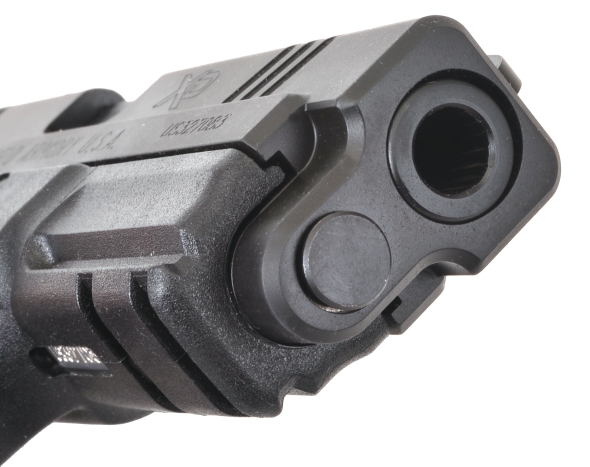
The 357 SIG has a way of making publishers of handload data and makers of reloading equipment look like members of the U.S. Congress; they appear to come down squarely on both sides of every issue, but then looks can be deceptive. As a beltless, rimless bottle neck round, most folks who design reloading tools would think “Headspace on the shoulder”. However, today as when the cartridge was introduced in 1994, the SAAMI cartridge and chamber drawings indicate headspacing at the case mouth.
CIP’s first 95-03-09 documentation and the 00-06-07 revision underscore several critical and basic dimensions, but do not use the term “headspace” as a reference. The current 08-09-23 CIP documentation has a “Note 6” which indicates headspacing at the case mouth. CIP never issued a drawing with an indication of the round headspacing at the shoulder. Both SAAMI and CIP information is accessible to the public, so feel free to go directly to the source documents to verify. Subsequently, by reloading die design standard, reloading dies should have been produced with a taper crimp to facilitate headspacing at the case mouth and use in semiauto pistols, but mostly they were not.

Above left, an early Hornady 357 SIG die set #544575 with a seater that roll crimps. According to Hornady Tech Support, the current product #546575 retains the roll crimp feature. RCBS dies, above right #23101 is the same as the current set number and it roll crimps. Far right, a Lee Factory Crimp die that is neither a roll or taper crimp, but rather puts a collet crimp at the case mouth whether a bullet likes it or not. Technically, they are all incorrect tools, but that does not mean they cannot be used to produce good ammunition. Redding’s 357 SIG die set #80434 includes a taper crimp seater die. Redding also offers a standalone taper crimp die for the 357 SIG #85434 for use with their non-crimping competition seater die.
Reloading manuals in the world of copy and paste
Most reloading manuals are an exercise in frugality. Cartridge narratives are copied from one generation to the next without revisions, which is why some cartridges are presented with obsolete powder types and why subjective opinion expressed between the covers can seem a little surreal. In Sierra’s words, “The 357 SIG headspaces on the case mouth (Oddly not the shoulder)” and then they go one to credibly describe the difference between bullets made for the 9mm Luger and the 357 SIG which is also takes a 0.355″ bullet. Then they close with a somewhat colorful and dramatic subjective conclusion questioning the future for this twenty two year old upstart cartridge.
Speer deduced that the cartridge headspaces on the case mouth, and offered a more generic explanation of the different 0.355″ bullet requirements for the 9mm Luger and 357 SIG. They then went on to sell a somewhat limited selection of their component and ammunition products with the flair of a mature Knut Hamsun. No, Knut didn’t say, Let’s win one for the Gipper”.
Hornady takes the approach of a politician at a town hall meeting regarding the 357 SIG with a somewhat vacuous narrative. Nosler avoids headspace comment and only cautions that bullets be seated firmly… which might cause me to assume it is OK to seat other cartridge bullets loosely. And, of course, Nosler does not give a reference cartridge overall length for their own products.
As Chuck would say, “Sometimes I will, then again I think I won’t”
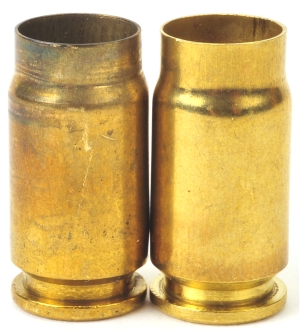 I would never fault anyone for using the case mouth as the locating surface and a tapered crimp. That is the spec approach. However, after checking a good number of chambers and handloading the cartridge for some time, I’ve found cases tend to run short and chambers tend to run long, which creates the concern that headspace could be excessive and cartridges might be hanging off the extractor when they are primer struck. So headspacing on the shoulder might be a better approach.
I would never fault anyone for using the case mouth as the locating surface and a tapered crimp. That is the spec approach. However, after checking a good number of chambers and handloading the cartridge for some time, I’ve found cases tend to run short and chambers tend to run long, which creates the concern that headspace could be excessive and cartridges might be hanging off the extractor when they are primer struck. So headspacing on the shoulder might be a better approach.
Unfortunately, new brass tends to have soft formed shoulders and do not present a solid and/or predictable locating surface. Subsequently, headspacing at the case mouth when working with new brass and headspacing at the shoulder for fully formed fired brass is not a bad approach. Left, unfired brass with soft formed shoulder and, far left, once fired brass with sharply formed shoulder and clear divisions between shoulder, neck and case body.
The trial cases assembled below were used to assess the best crimp. #1 Hornady roll crimp, #2 RCBS roll crimp, #3 Lee Factory crimp, #4 no crimp. All cases were put through an RCBS full length sizer die with a 0.353″ expander ball before assembly which, after brass spring back measured 0.351″ inside the case mouth.
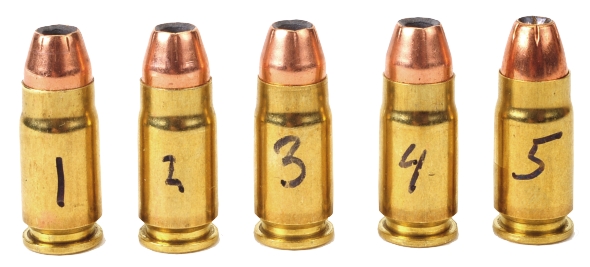
All and all, in the absence of a cannelure the roll crimps held about as well as no crimp, requiring not a whole lot of fore to set the bullet back into the case. The Lee Factory Crimp die, with only half turn collet compression anchored the bullet tightly. I put some unprimed and uncharged assemblies together for testing and placed each in the arbor press. No more than bullet seating pressure was required to push a bullet into the case in the roll and no crimp samples. The assembly with the Lee Factory Crimp was so tight the case collapsed before the bullet budged.
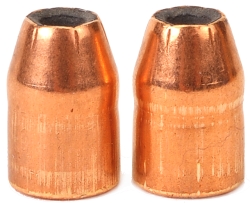
One bullet maker goes on and on about not using a factory crimp die as it will deform a bullet when applied. Setting aside the fact that they also make reloading tools, I am not sure how they think the cannelure gets into bullets shipped from the factory with that feature. Embossed or coined at the factory or evenly applied with collet jaws seems of little difference to me. I have a cannelure tool in the shop that basically presses a cannelure into a plain bullet.
Measuring some of the bullets that passed through the Lee Factory Crimp Die, turned in half a turn made a compression ring of 0.348″. Adjusting down a full turn made a ring 0.343″ in diameter. In either case, the bullet did not bulge out above or below the compressed area, nor was the bullet unevenly distorted from the applied pressure. Going back to the arbor press the half turn adjusted crimp held as tightly as the full turn, so that became the standard used for the duration of the project. The base circle for a cannelure is 0.005″ deep and 0.002″ at the outside. In the case of the Lee Factory Crimp, without serrations it is full case to bullet contact.
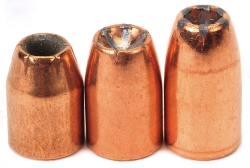
Three bullet weights were selected for handloading. All have substantial parallel shanks and relatively blunt ogives, all expand properly at SIG velocity, all typically demonstrate good accuracy. Truncated, they yield a proper COL without exceptionally deep seating.
Some of my favorite 9mm bullets will not work with the 357 SIG. A long ogive seats below the case mouth and reduces the case to bullet contact. So I always assemble dummy rounds for developing combinations to make sure everything is going together properly. A small gauge fashioned in the shop is a double check.
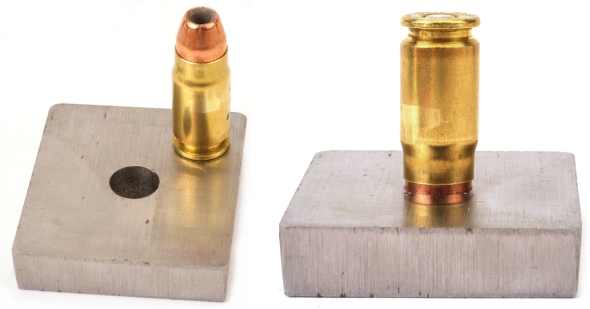
With a 0.353″ hole in a 3/8″ square of steel, as long as copper is visible between the steel block and inverted cartridge there is full contact between the case neck and the parallel side of the bullet shank. No exposed copper means the ogive extends into the case mouth.
Couldn’t make up my mind so I picked all three…
An RCBS sizer was used because it did a good job of shoulder forming. The Hornady expander was use to slightly fare each case mouth. 357 SIG cases distort fairly easy so it is good to have a clean start when seating. An expanded in not included in the RCBS set. The RCBS seater was used because it provides good case/neck support and the Lee Factory Crimp Die as selected to crimp and finish up.
 |
Warning: Bullet selections are specific, and loads are not valid with substitutions of different bullets of the same weight. Variations in bullet material and length will alter net case capacity, pressure and velocity results. Primer selection is specific and primer types are not interchangeable. These data represents maximum loads in our firearms and test equipment and may easily be excessive in other applications. All loads should be reduced by 5%, and developed following safe handloading practices as represented in established reloading manuals produced by component manufacturers. Presentation of these loads does not constitute a solicitation for their use, nor a recommendation.
|
||||||||||||||||||||||||||||||||||||||||||||||||||||||||||||||||||||||||||||||||||||||||||||||||||||||||||||||||||||||||||||||||||||||||||||||||||||||||||
|
|||||||||||||||||||||||||||||||||||||||||||||||||||||||||||||||||||||||||||||||||||||||||||||||||||||||||||||||||||||||||||||||||||||||||||||||||||||||||||
Longshot ran a bit warm, but OK and it produced good velocity. HS-6 lost a step or two at maximum bullet weight. Vectan drove me crazy, but I have not given up. The data published by Vectan is so soft I have not has a rifle or handgun round that came within hundreds of feet per second of their data. In this case, Ba9 is supposed to be on part with Unique in terms of speed, but Ba9 seems considerably slower. While well over Vectan’s data, there was no sign of excessive pressure being generated, report was mild and so was recoil. Perhaps a bit heavier on charges with yield a significant change?
The Springfield Armory XD
The Springfield Armory XD full size performed admirably. No jams, no feed problems and accuracy was good. The pistol feels right in the hand, form and balance, and there was little fatigue after extended shooting sessions. It is also a good looking firearm with a finish that holds up.
If there was one issue that made me a little crazy it was lazy and inconsistent ejection. Sometimes it popped empties into the catch net, sometimes in top of my head or on the bench at my hands and, one, into the hood of my sweatshirt. My assessment is that the gun is a little too heavily sprung. On the other hand, that is a good way to prevent a gun from beating itself to death with relatively high intensity rounds. Easy enough to correct if the problem annoyed me enough.
There are a couple of things I’d like to change on the XD, so we will hold off on a final conclusion.

Email Notification